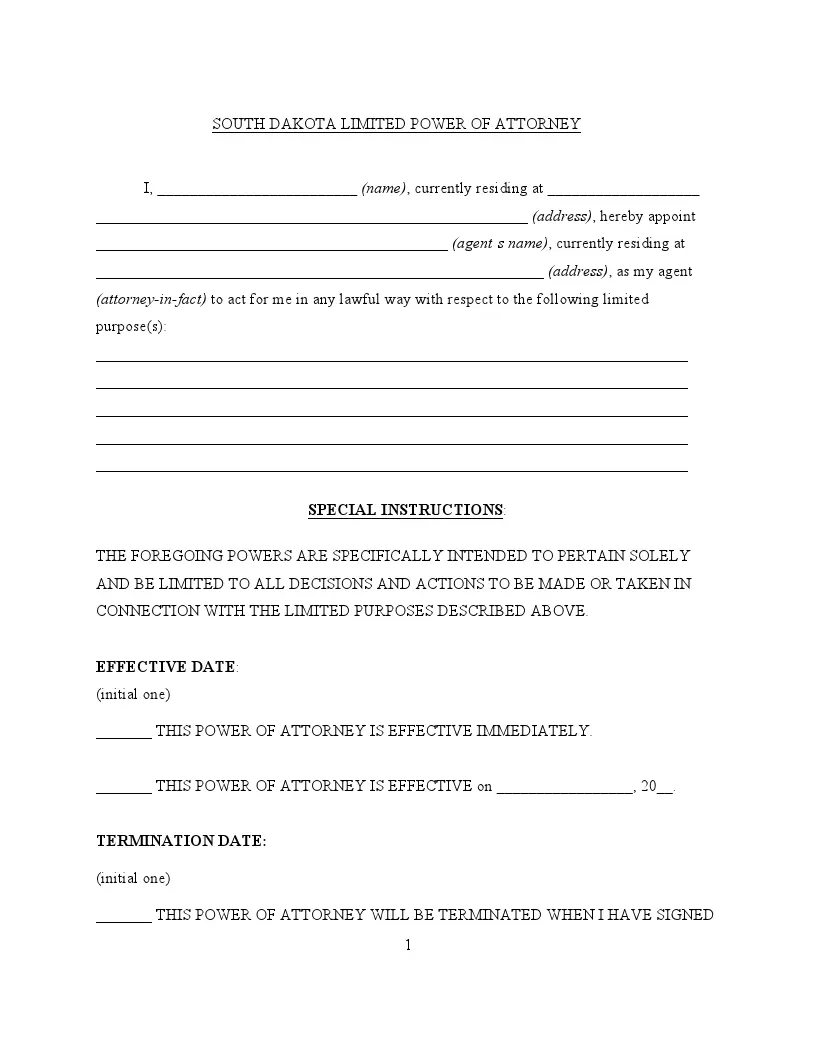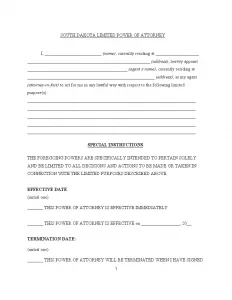South Dakota Limited Power of Attorney Form
A South Dakota limited power of attorney is a legal document that allows an individual (the “principal”) to grant specific powers to another person (the “agent” or “attorney-in-fact”) to act on their behalf. This document restricts the agent’s authority to a particular activity or set of activities, typically for a defined period.
The limited power of attorney explicitly outlines the powers granted. For instance, the principal may authorize the agent to handle financial transactions, sell property, or manage specific legal affairs, but only those specified. This type of power of attorney is often used for a limited time. It may be set to expire on a specific date or upon the completion of a particular task. If you consider giving your agent broader powers, use our South Dakota power of attorney forms.

Build Your Document
Answer a few simple questions to make your document in minutes
Save and Print
Save progress and finish on any device, download and print anytime
Sign and Use
Your valid, lawyer-approved document is ready
In South Dakota, the signing requirements and laws for a limited power of attorney are guided by specific statutes to ensure the document is legally enforceable. According to the South Dakota Codified Laws (Sections 59-12-1 to 59-12-43), specific criteria must be met when executing this type of document:
- “Agent” refers to any person granted authority to act on the principal’s behalf, including roles like original agent, co-agent, successor agent, or delegatee.
- An agent can act and execute duties as explicitly outlined in the power of attorney document.
- A notary must affirm the document to be considered properly executed and valid.
The principal must specify the extent of powers granted and the circumstances under which these powers will be executed.
South Dakota Limited Power of Attorney Form Details
| Document Name | South Dakota Limited Power of Attorney Form |
| Other Name | South Dakota Special Power of Attorney |
| Relevant Laws | South Dakota Codified Laws, Section 59-12-23 |
| Avg. Time to Fill Out | 8 minutes |
| # of Fillable Fields | 32 |
| Available Formats | Adobe PDF |
Filling Out South Dakota Limited POA
Establishing a limited power of attorney in South Dakota is a simple procedure that enables you to appoint a representative to handle certain legal affairs on your behalf. This manual will assist you in correctly filling out the document.
1. Fill in Personal Details
Please enter your full name and complete residential address in the spaces provided at the start of the form. This step identifies you as the principal, the person granting the power to another individual (the agent).
2. Appoint Your Agent
Identify the individual you choose as your agent, including their name and contact information. As outlined in the limited power of attorney, this person can carry out responsibilities on your behalf. Ensure the information is correct to prevent misunderstandings regarding the agent’s identity.
3. Define the Powers Granted
Clearly state the specific powers you are granting to your agent. These should be detailed in the “Special Instructions” section of the form. Be explicit about what the agent is allowed and not allowed to do. This section is crucial as it limits the agent’s power to the specified actions.
4. Set the Effective and Termination Dates
Decide when the limited power of attorney will become effective and when it will terminate. You can make it effective immediately or start on a future date. Similarly, you can terminate it on a specific date, upon a written revocation, or if you are incapacitated. Then, initial next to your choice for both effectiveness and termination.
5. Designate a Successor Agent
If you wish, appoint a successor agent who will take over should your primary agent be unable to serve. Include the successor’s full name and address. This step is optional but recommended to ensure continuity should the first agent become unavailable.
6. Sign and Notarize the Form
After filling out the form, sign it in the presence of a notary public. The notary will verify your identity and confirm that you are willingly signing the form and are aware of its contents. The notarization process is vital as it adds a layer of legal authenticity to the limited power of attorney.
